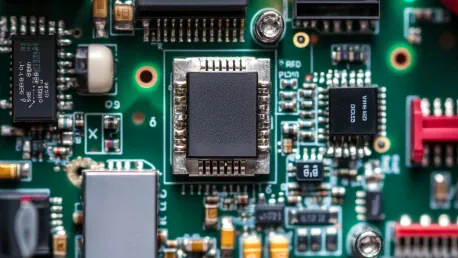In the modern interconnected landscape, embedded systems hold a critical position in managing and processing enormous amounts of data across a plethora of applications. As these systems become increasingly integral to big data environments, ensuring their security has emerged as a paramount concern. This article delves into the unique security challenges faced by embedded systems in big data contexts and explores effective strategies to mitigate these challenges.
Understanding Embedded Systems in Big Data Contexts
Embedded systems refer to specialized computing units designed to perform dedicated functions within larger systems. Within the big data realm, these systems are tasked with collecting, processing, and transmitting data from different sources such as sensors and IoT devices to centralized repositories for analysis. These systems often operate under specific and constrained resources, which necessitates particular hardware and software optimizations that are distinct from traditional computing environments.
The Role of Embedded Systems
The efficiency and reliability of embedded systems make them indispensable in diverse applications ranging from industrial automation to smart city infrastructures. They play a critical role in the seamless operation of big data ecosystems by managing and processing vast amounts of real-time data. For instance, embedded systems in healthcare collect and monitor patient data through wearable devices, while in transportation, they streamline traffic management by analyzing data from various sensors.
Beyond merely facilitating data collection and processing, these systems also ensure data is securely transmitted to centralized repositories for further analysis. This continuous data flow is vital for decision-making processes that depend on accurate, real-time information. However, the integration of embedded systems into such complex environments brings inherent security challenges that cannot be overlooked if data integrity and system reliability are to be maintained.
Importance of Security
As the number of connected devices contributing to big data escalates, embedded systems become critical to sectors such as healthcare, transportation, finance, and industrial automation. The success of data-driven decision-making in these sectors heavily depends on embedded systems’ ability to securely process and store information while minimizing vulnerabilities that could be exploited by cyber threats. In healthcare, data breaches might lead to unauthorized access to sensitive patient information, while in industrial automation, compromised data could halt operations or result in hazardous malfunctions.
To prevent breaches and data corruption, embedded systems must manage vast amounts of real-time data efficiently while maintaining high security. This necessity underscores the importance of defending these systems against potential cyber threats through robust security measures that encompass encryption, authentication, and continuous monitoring. Only with these protections in place can organizations harness the full potential of big data without compromising the safety and confidentiality of the information processed.
Data Security Challenges in Embedded Systems
Resource Constraints
Despite their numerous advantages, embedded systems encounter unique security challenges. One significant challenge is the constraint on resources, as many embedded devices have limited processing power and memory, making it challenging to implement sophisticated security protocols without impacting performance. The limited resources often mean that these systems cannot afford the overhead associated with extensive encryption algorithms or comprehensive intrusion detection systems.
This limitation complicates the deployment of encryption, authentication, and other security mechanisms effectively. For example, robust encryption techniques like AES or RSA require significant computational resources which might not be available in low-power devices. As a result, developers might have to compromise between security and performance, potentially leaving the system more vulnerable to attacks. Managing these constraints while ensuring adequate security remains a persistent challenge for developers and manufacturers of embedded systems.
Physical Accessibility
Another notable challenge is physical accessibility. Many embedded systems are operational in remote or unsecured locations, making them prone to tampering and unauthorized access. Unlike conventional IT systems housed in controlled access data centers, embedded systems often function in open environments such as industrial sites, public spaces, and connected vehicles. This exposure renders them easier targets for physical attacks and manipulation.
Attackers can exploit these vulnerabilities to introduce malicious firmware, manipulate data flows, or disable critical functions. For instance, an embedded system in a traffic control device might be accessed physically to alter signal timings, leading to traffic disruption. Similarly, embedded systems in public IoT devices can be tampered with to extract sensitive information or infect the network with malware. Safeguarding these systems involves not only securing data but also fortifying the physical components against unauthorized access and tampering.
Specific Security Concerns in Big Data Applications
Data Integrity
When embedded systems are integrated into big data applications, they face additional security concerns. One pressing concern is data integrity. Ensuring that data collected from numerous devices remains unaltered during transmission and storage is critical for accurate analysis and decision-making. Even minimal alterations in sensor data or analytics inputs can lead to incorrect predictions, faulty automation responses, and compromised business strategies.
For example, in healthcare applications, inaccurate data transmitted from patient monitoring systems can result in incorrect diagnoses and treatment plans. Similarly, in industrial automation, altered data can trigger inappropriate responses from machinery, leading to operational inefficiencies or accidents. Therefore, maintaining data integrity across all stages of the data lifecycle, from collection and transmission to storage and analysis, is paramount for the reliability of big data systems and the validity of the insights drawn from them.
Scalability and Interoperability
Another concern is the scalability of security measures. As the number of connected devices grows, maintaining consistent and effective security protocols across all nodes becomes increasingly complex. In a large-scale industrial network, for example, embedded systems must operate seamlessly with thousands of other devices while ensuring encrypted communication, authentication, and access control policies remain intact. This scalability challenge requires robust, yet flexible, security frameworks that can be efficiently scaled with the growing network.
Interoperability also poses a challenge in embedded systems for big data applications. The need for seamless communication between diverse devices can create security gaps if not adequately managed. Different manufacturers may adopt varying standards and security practices, leading to weak points in a networked ecosystem. Without standardized security measures, attackers can exploit inconsistencies to gain unauthorized access, intercept sensitive data, or disrupt system functions. Achieving interoperability while maintaining stringent security standards is essential for creating a cohesive and secure big data environment.
Strategies to Mitigate Security Challenges
Encryption and Authentication
Addressing the security challenges in embedded systems requires a multi-layered approach. Implementing robust encryption methods ensures that data remains confidential and secure during transmission and storage. Secure cryptographic techniques such as AES and RSA encryption can mitigate the risks of data interception and unauthorized access. By encrypting data at every stage, from collection to final storage, organizations can protect sensitive information from being compromised during transit or at rest.
In addition to encryption, integrating strong authentication protocols is crucial for verifying the legitimacy of devices and users accessing the system. Methods such as biometric verification, hardware-based security keys, and two-factor authentication can significantly enhance the security of embedded systems. These measures help ensure that only authorized entities can interact with the system, thereby reducing the risk of unauthorized access and potential data breaches.
Regular Updates and Standardized Protocols
Regular firmware updates are crucial for protecting against known vulnerabilities and emerging threats. Manufacturers must provide timely security patches, and organizations should implement automated update mechanisms to ensure embedded devices remain protected. Automatic updates reduce the risk associated with outdated software, which hackers can exploit. It’s essential that these updates are applied consistently and without delay to maintain a secure operational environment.
Additionally, adopting standardized protocols enhances interoperability and reduces security risks. Employing widely accepted communication standards ensures that devices can interact securely and cohesively within a network. Protocols like Transport Layer Security (TLS) and Public Key Infrastructure (PKI) can establish trusted communication channels, providing a layer of security that prevents unauthorized interception and tampering. Standardized protocols foster collaboration between different manufacturers and developers, ultimately resulting in a more secure and reliable network of embedded systems.
Ecrin Systems’ Approach to Data Security
Custom Engineering Solutions
Ecrin Systems is dedicated to delivering secure embedded solutions tailored to meet the demands of big data applications. Their approach includes customizing engineering solutions with advanced security features to satisfy specific client requirements. By integrating security at the design stage, Ecrin ensures that their solutions are not only robust and functional but also resilient to various cyber threats.
This customization process involves a thorough analysis of potential vulnerabilities and the implementation of bespoke security measures. For example, Ecrin might develop specialized encryption modules or incorporate tamper-resistant hardware components based on the needs of a particular application. Such tailored solutions ensure that the embedded systems are equipped to handle specific security challenges relevant to the industry and operational environment.
High-Reliability Applications
Ecrin Systems specializes in high-reliability applications, catering to industries such as aerospace, defense, and industrial automation, which demand stringent security measures. Their expertise in developing ruggedized computing solutions ensures that embedded systems remain operational under extreme conditions while maintaining uncompromised security. For instance, aerospace applications require systems that can withstand high levels of radiation and extreme temperatures without succumbing to security breaches.
Additionally, Ecrin emphasizes lifecycle management in securing embedded systems. Through secure device provisioning, encrypted firmware updates, and real-time monitoring, they help organizations maintain the integrity of their embedded infrastructure throughout its operational lifespan. This comprehensive approach ensures that security is upheld from deployment to decommissioning, thereby significantly reducing the risk of vulnerabilities introduced over time.
Conclusion
In our increasingly connected world, embedded systems play a crucial role in managing and processing vast amounts of data across various applications. As these systems become more integral to big data environments, ensuring their security has become a top priority. This rise in importance brings a unique set of security challenges that must be addressed to protect the integrity and confidentiality of the data they handle.
This article explores the specific security issues that embedded systems encounter within big data contexts and examines effective strategies to mitigate these problems. With the expanding presence of embedded systems, their security is paramount to prevent data breaches and maintain proper functionality. Innovative approaches and new thinking are needed to safeguard these systems and the sensitive information they process.
By understanding the particular vulnerabilities of embedded systems and implementing robust security measures, we can confidently progress in our reliance on big data without compromising safety. This involves a combination of technological advancements, rigorous testing, and constant vigilance to combat evolving threats in the digital age.









